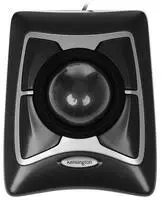Kensington 64325 - Instrukcja obsługi

Mysz komputerowa Kensington 64325 – Instrukcja obsługi, czytaj za darmo online w formacie PDF. Mamy nadzieję, że to pomoże rozwiązać wszelkie problemy, które mogą się pojawić. Jeśli masz dodatkowe pytania, skontaktuj się z nami za pomocą formularza kontaktowego.
K64325
901-4167-03
Expert Mouse
®
Wired Trackball
Register Now!
Enregistrer maintenant !
Jetzt registrieren!
Nu registreren
Registrar ahora
Registra adesso
Regisztràljon most!
Zaregistrujte se nyní!
Zarejestruj się!
Зарегистрироваться!
Registe-se agora!
register.kensington.com
QUICK START GUIDE
GUIDE DE DEMARRAGE RAPIDE
KURZANLEITUNG
SNELSTARTGIDS
GUIDA RAPIDA
GUÍA RÁPIDA
GYORSKALAUZ
PŘÍRUČKA ZAČÍNÁME
SZYBKI START
КРАТКОЕ РУКОВОДСТВО
ПОЛЬЗОВАТЕЛЯ
MANUAL DE INÍCIO RÁPIDO
kensington.c om/register
www.kensington. com/support
Australia
1300 881 931
België / Belgique 02 401 2395
Brasil
14 3235-4003
Canada
1 800 268 3447
中国
400 0684 219
Denmark
80 250966
Deutschland
0692 222 3654
España
911 146 735
Finland
0800 9 15697
France
01 7671 0404
Hong Kong
00852 2823 5130
Hungary
06 20 9430 612
Ireland
01 431 1395
Italia
02 3604 7030
Japan
+81 04-7129-2135
México
55 15 00 57 00
Nederland
010 713 1882
New Zealand
0800 539 26273
Norway
80017520
Österreich
0800 677 873
Kensington Computer Products Group
A Division of ACCO Brands
1500 Fashion Island Blvd, 3rd Floor
San Mateo, CA 94404
Importado por ACCO Mexicana
S.A. de C.V.
Circuito de la Industria Norte # 6,
Corredor Industrial Toluca Lerma,
Lerma México Cp. 52004
R.F.C. AME640229-1W3
ACCO Brands Europe
A Division of ACCO Brands Europe
Oxford House, Oxford Road
Aylesbury, Buckinghamshire,
HP21 8SZ United Kingdom
Acco Brands Chile S.A.,
Avda. Presidente Riesco
# 5711,
oficina 201
Las Condes, Santiago, Chile
CP 7561114
Dovozce/Dovozca:
Esselte, s.r.o., V Lužich 818,
142 00 Praha 4, Česka republika
Импортер:
ООО “Эссельте”, Россия, 125040,
Москва, 3-я улица Ямского поля, д.18,
тел. +7(495)933-27-63
Товар не подлежит обязательной
сертификации.
Срок годности не ограничен.
ACCO Brands Canada
7381 Bramalea Rd
Mississauga, ON L5S 1C4
Canada
Importado e Distribuído por:
Tilibra Produtos De Papelaria Ltda.
CNPJ: 44.990.901/0001-43
Rua Aymorés, 6-9 – Bauru/SP – Brasil
CEP 17013-900
Forgalmazza:
Esselte Kft, Vaci ut 76. V. torony I.
emelet,
1133 Budapest, Magyarorszag
θндіруші:
“Esselte Polska Sp. z o.o. ”, ul. Przemysłowa 11A,
26-900 Kozienice
Импорттаушы: “АБДИ Компани” АҚ, Алматы қ.,
Сейфуллин данғ. 465/191”
Тауар міндетті сертификаттауды қажет етпейді.
Жарамдылық мерзімі шектелмеген.
Importer:
LEITZ ACCO Brands GmbH & Co KG
Siemensstraße 64
70469 Stuttgart
Germany
Importator:
Esselte Sales SRL, Gheorghe Ţiţeica 121C,
Sector 2, Bucureşti, Romania
ACCO Brands Asia Pte Ltd
5A Toh Guan Road East #06-03,
Singapore 608830
Dystrybutor:
Esselte Polska Sp. z o.o.,
ul. Przemysłowa 11A,
26-900 Kozienice
Дистриб’ютор:
Ессельте Польска Сп. з о.о., вулиця
Пшемислова, 11А, 26-900 Koзеніце
Товар не підлягає обов’язковій
сертифікації.
Термін придатності необмежений.
ACCO Brands Australia-
Kensington
2 Coronation Avenue
Kings Park
NSW 2148
Australia
アコ・ブランズ・ジャパン株式会社
〒164-8721
東京都中野区本町1-32-2
ハーモニータワー14F
http://www.kensington.com/jp
E-MAIL: JP.Kensington@acco.com
限公司
广州市爱珂贸易有
上海分公司
中国上海市长宁区
延安西路2299号1509室
电话:021-61368966
传真:021-61710161
www.accobrands.cn
명칭:마우스
인증
번호:
R-R-KCP-M01398
모델명
:M01398
제조자
:Kensington Computer Products Group
제조
년월일
:
레퍼런스 제품
라벨
제조국 :중국
"Ładowanie instrukcji" oznacza, że należy poczekać, aż plik się załaduje i będzie można go czytać online. Niektóre instrukcje są bardzo obszerne, a czas ich ładowania zależy od prędkości Twojego internetu.








